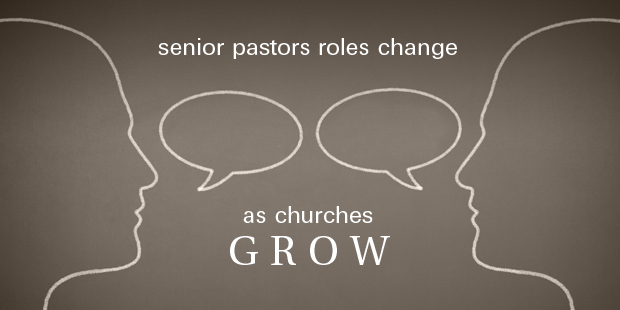
Senior Pastors Roles Change as Churches Grow
Twenty-two years ago, when Tim Harlow became the senior pastor of Tinley Park Church of Christ, the following newspaper ad was considered the cutting edge of church marketing.
Senior pastors who have been at the same church for any length of time can most likely complete this exercise: Think back through some of the stages of your congregation’s development, and take note of how your role as a senior leader had to shift during those various stages.
For Parkview Christian Church, Orland Park, IL, and Senior Pastor Tim Harlow, this time travel challenge takes him back through 22 years with the congregation—a time span in which he:
– Broke through growth barriers as an aggressive young pastor in an established and plateaued church—“I made a lot of people mad,” he says.
– Created a new vision and developed structure to make it happen—“It was about rallying the troops around the idea of what God could do instead of what God had done.”
– Pushed through a downturn and a period of burnout—“Much of my leadership through these times comes from a God-given stubborn, sometimes clueless, leadership gift.”
– Started to think about the next generation and who would take the leadership baton—“Where do I go next? My wife and I have recently become empty nesters,” Tim says.
Do any of those phases sound familiar? You might have different labels for the development stages of your church; but there’s a strong chance your role has also shifted along the way to adapt to your congregation’s leadership needs—and it’s probably still changing.
Tim’s certainly did.
Breaking Through Barriers
For Tim, it’s always been about removing barriers for lost people to have a chance to find their way home—even after nearly three decades in the same place with barriers that cropped up during his watch. “Do we really think that there is anything difficult about connecting people with their loving heavenly Father? It’s the easiest job in the world,” Tim says. “It becomes difficult only when those on the inside forget about what it’s like on the outside.”
In the early days of taking over a congregation founded 40 years prior to his arrival, that commitment to connect with outsiders meant “being stubborn and continually fighting against the ‘we’ve-always-done-it-that-way’ mindset and the fence that has been keeping people out,” Tim says.
The good thing for Tim at this stage was he “didn’t have a problem being aggressive,” as he voices it, when it came to setting direction for the church. That was also his downfall at times. “The unfortunate part was the lack of wisdom and the inability to choose the right battles,” he says.
But there were—and still are—battles worth waging. “Every existing church comes with deeply entrenched barriers that current members don’t even realize exist,” Tim says. “Once we become a part of the inner workings of any organization we stop seeing what it looks like from the outside, and we have to keep breaking through those barriers.
Creating New Vision—and Building For It
Once he laid a foundation, Tim felt it necessary to sound a new rallying cry that included relocation, staff changes and fundraising.
“I grew through this stage by engulfing myself with the people, education, and inspiration that would help me cast an accurate and articulate vision,” Tim says. “If I hadn’t known what I was talking about by this stage and didn’t have some level of credibility, no one would have listened.”
This stage was at least five years in the making, and moved Tim to figure out what he was best at, and what he needed to pass on to others because they were better at it. “I had no aptitude for organization; I’m the leader not the manager,” says Tim, who guided the church to change its name, among other changes. “My growth in this stage was about recognizing my limitations and surrounding myself with people who could help me.”
Downturn and Burnout
Parkview was seven years into its turnaround when a tipping point came. Relocation was on the table, but the church’s bylaws required a congregation-wide vote to move forward. The congregation voted 56-44 in favor of the move.
“It’s all we needed to get it done,” says Tim, who in more recent years has seen Parkview become one of the fastest-growing churches in the nation. “But it was taking a big chance to move forward with only half the congregation’s support.”
Then came the inevitable. As Parkview moved into its new facility with four weekend services, Tim was completing doctoral studies and his three daughters needed more time from him. Trying to juggle all these concerns, he hit the wall. “It was a very perfect storm,” Tim says. “And it was a great thing, because it forced the church and mostly forced me to realize that I had to concentrate on the things that only I could do.”
Next Up, Next On Deck
Which brings Tim—and maybe you, too—to the point of considering who will take the church on the next leg of its development after his ministry race is finished?
The church isn’t pursuing a formal succession plan yet. “I think it’s too early, and I’m planning on being here 15 more years or maybe more. I’ve seen too much frustration with long-term succession plans,” he says. But the next generation of leaders, and what Tim will leave them with, is very much on his mind.
“I believe that a large part of my ministry now at this stage of my life is about training the next generation of leaders—whether that’s here or elsewhere,” says Tim, who turned 50 in 2011. “I have to be about 2 Timothy 2:2.”
That emphasis on training others also includes plans to expand Parkview’s auditorium. “I don’t wonder what I’ll do as my next step at Parkview. But in light of the economy and current trends in Christendom, I wonder about raising $14 million in the next few years,” Tim says. “Does my kids’ generation need a larger auditorium? It’s an anxiety of not knowing what’s going to happen next in our culture.”
The Constants
Even through all the stages of personal and corporate growth and change, Tim recognizes some mainstays: a heart for “lost sheep” and solid preaching.
But he would change one thing: using that platform to grind an axe at times. “I sometimes ran people off through my preaching—on purpose,” Tim says. “They needed to leave, but I could have been more graceful. Using the pulpit to say things is the same as sending an email. It’s better to have a discussion with someone individually and in person. There is a difference between casting vision and playing politics.”
“The most important thing I’ve done well is preach,” Tim says. “People will put up with a lot of things if they are getting fed. You can be the greatest church leader in the world, but if the preaching is not a priority, it’s not going to work. I am far from original, but I always spend plenty of time preparing and preaching the Word.”
Read more from Warren here.

Tags: Senior Pastor, Staff Leadership Roles, Structure, Warren Bird












